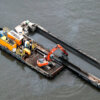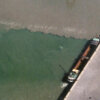Coastal protection of beaches, cities and communities located close to oceans and seas is a primary activity of the dredging industry.
Vulnerable communities
According to the United Nations Environmental Programme (UNEP), half the world's population lives within 60 kilometres of the sea, and three-quarters of all large cities are located on the coast. With the risks of climate change and the pressure of pollution from urban areas, these communities are more and more vulnerable.
These densely populated coastal cities are economic hubs, often representing major ports with their related industrial businesses, such as shipping and commercial fishing. Coastal areas also support tourism with a focus on beaches, hotels and cruise harbours.
To complicate matters, these coastal areas are also home to rich and fragile natural habitats.
Causes of coastal erosion
Coastal protection provides defence against flooding and erosion, which can be caused by:
- waves and tides,
- winds,
- currents and
- littoral drift, i.e., the transport of sediments along a coast at an angle to the shoreline in the littoral zone (the surf line).
Climate change, resulting in melting ice caps and more frequent and more severe storms, have aggravated these conditions.
Coastlines differ
Coastlines and their ecosystems vary considerably but all require some degree of maintenance and protection, for instance:
- Sandy beaches with dunes are subject to the waves, tides, winds, and currents which can drag sand out to sea and bring it back in places where it may not be needed. Maintenance dredging seeks to replenishment these beaches and restore their natural beauty as well as their function as a barrier against flooding.
- Wetlands provide essential ecosystem services including erosion and flood protection, protection of natural habitats with unique species of flora and fauna. Commercial fisheries as well as recreational facilities are often near wetlands.
- Coral reefs whether in warm or cold waters are unique natural barriers, protecting coastal cities, communities, and beaches from ocean waves and limiting the vulnerability of coasts to wave action and storm damage.
- Mangroves provide natural protection and can be part of coastal protection strategy against wave damage, storms, and erosion. Their dense roots bind and build soils and slow down the effects of wind and waves. Restoring and protecting them by careful dredging should be a part of an overall coastal defence scheme.
Dredging must always consider these assets and can play a key role in protecting and restoring them.
Dredging & coastal protection
A variety of dredging solutions may include:
soft engineering solutions including sand dune stabilisation and beach nourishment.
- construction of hard structures such as seawalls;
- breakwaters to protect exposed harbours;
- underwater bunds;
- fixed piers or open-piled jetties;
- sand traps such as groynes;
- coastal armouring with revetments, gabions, riprap and acropodes.
Subjects
Environment
-
 Building with Nature
Building with Nature
-
 Climate Change
Climate Change
-
 CO2 & Other Emissions / Greenhouse Gases
CO2 & Other Emissions / Greenhouse Gases
-
 Coastal Protection
Coastal Protection
-
 Confined Disposal Facilities
Confined Disposal Facilities
-
 Coral Reefs
Coral Reefs
-
 Deltas
Deltas
-
 Ecosystem Services
Ecosystem Services
-
 Environmental Impact Assessment
Environmental Impact Assessment
-
 Environmental Monitoring
Environmental Monitoring
-
 Environmental Monitoring and Management Plans
Environmental Monitoring and Management Plans
-
 Flood Defence
Flood Defence
-
 Management Practices for the Environment
Management Practices for the Environment
-
 Mangroves
Mangroves
-
 Remediation dredging (Contaminated sediments)
Remediation dredging (Contaminated sediments)
-
 Sustainability
Sustainability
-
 Turbidity
Turbidity
-
 Underwater Sound
Underwater Sound
-
 Wetlands
Wetlands
related
Articles
The importance of flocculation in dredge plume modelling

Numerical models are often used to predict the magnitude and behaviour of dredge plumes to help assess and manage any environmental risks. To provide a realistic prediction of plumes resulting from dredging, numerical models require information on the rate at which sediment is suspended by the dredging, along with the characteristics of the suspended sediment. Previous investigations have shown that in the marine environment, fine-grained sediment suspended by natural processes and dredge-related activities are typically present as aggregated particles known as flocs. This article considers the importance of including the process of flocculation in dredge plume models.
Deploying private capital to accelerate the green transition

Green solutions in ports, waterways and coastal projects have increasingly become available thanks to many years of research and pioneering efforts in practice. These sustainable and/or nature-based solutions have shown to be good alternatives for classic solutions, but application is far from mainstream yet. One of the major hurdles is the lack of access of private capital to finance these kinds of solutions despite the strong interest of capital markets in green infrastructure opportunities. Identifying the hurdles and paving a way forward to overcome these hurdles could therefore help to increase the uptake of those green solutions.
Climate Risk Overview tool: mapping naturebased flood protection opportunities

The planet is facing enormous challenges caused by human activity, increasing the vulnerability of communities and ecosystems to the forces of nature. This is worsened by the effects of climate change, which is threatening the world’s coastal defences. Van Oord has responded to these challenges by developing the Climate Adaptation Action Plan. The plan is designed to encourage meaningful dialogue between stakeholders in order to provide ready-to-scale marine solutions that help increase the resilience of the communities and ecosystems of coastal areas.
Shaping the engineers of tomorrow

During his distinguished career as professor of Coastal Engineering at Delft University of Technology (TU Delft), Kees d’Angremond served as head of Hydraulic and Offshore Engineering, chair of the department of Hydraulic and Geotechnical Engineering, and dean of the faculty of Civil Engineering from 1989 to 2001. Now professor emeritus, he still works as an advisor and independent consultant. We invited Kees to a conversation with Stefan Aarninkhof, professor of Coastal Engineering and chair of the department of Hydraulic Engineering at TU Delft, to talk about their careers in the dredging industry and the role of academia in the industry today.
The impact and costs of Building with Nature projects

The use of nature and natural processes is an innovative way to increase water safety and create added value through nature development and recreation. This exploratory study provides an initial inventory of the impact and costs of existing Building with Nature projects in the Netherlands. It also includes an analysis of the decision-making process in choosing this type of project and identifies success factors. Building with Nature projects deliver added value but often also involve additional costs compared to traditional reinforcements. These costs give an indication of what we as a society are prepared to pay for the development of nature and recreation as part of hydraulic engineering projects.
Balancing project progress and limited system knowledge in Amatique Bay

The development of a new marine project demands a system approach in which all aspects, including technical, economic, environmental and social, are considered and integrated equally and at an early stage. While insufficient information may be available to make informed decisions, choices need to be made to progress a project, assess impacts and risks, and engage stakeholders. This article explores the case of a new port terminal in Amatique Bay, Guatemala. A method was developed to assess, at an early stage, the potential negative impacts on seagrass habitats from the disposal of dredged material at different locations, while having limited real-time and location-specific information at hand.
Creating mangrove habitat for shoreline protection

Over the past decades, there has been a growing interest in exploring innovative ways to minimise the environmental footprint of coastal developments and in nature-based approaches for shoreline protection. At Mubarraz Island near Abu Dhabi (UAE), an international oil company beneficially reused ~12 million m³ of dredged material to protect pipelines, construct a causeway and create mangrove habitat to manage coastal erosion. This ‘Working with Nature’ approach has provided a cost-effective nature-based solution for shoreline protection, with added benefits for biodiversity conservation.
Building with Nature: Sustainable Protection of Mangrove Coasts

Building with Nature is an innovative approach that combines natural processes with innovative engineering methods to realise sustainable projects. Permeable dams are being utilised as part of a Building with Nature solution to help restore the eroding mangrove-mud coast of the Demak district in central Java, Indonesia.
Publications
Videos
Presentation: ‘Hondsbossche and Pettemer Sea Defence an example of sustainable asset valuation’ by Sven Kramer (Van Oord) − Director Sustainability

This presentation shows the practical implications of taking all externalities into consideration as early as possible in a project procedure. It is complex but asset valuation is gradually becoming more and more feasible for large infrastructure projects. The independent International Institute of Sustainable Development carried out a study on the benefits of “Nature Based” coastal Protection compared to traditional “Grey” solutions. Their report is expected to be published mid-November 2021.
Presentation: ‘Sand as a Resource’ by Jan Fordeyn (Jan De Nul) − Director Project Development & Conceptual Design

In our day to day lives most of us are not aware of how many industries rely on sand as a part of their working process. The amount of sand consumed has dramatically increased over the last few years and this can be largely contributed to the world wide construction boom. How is this going to affect us in the future?
Webinars
Webinar: The Multiple Benefits of the Hondsbossche and Pettemer sea dunes, valued by the SAVi methodology

This webinar is especially of interest for policymakers, infrastructure developers, investors and other stakeholders with an interest in green infrastructure. But also for both technical and non-technical professionals in dredging-related industries like consultants and advisors at port and harbour authorities, offshore companies and other organisations that execute dredging projects.



















